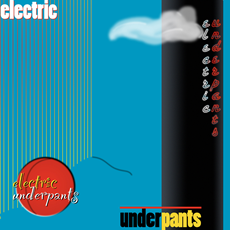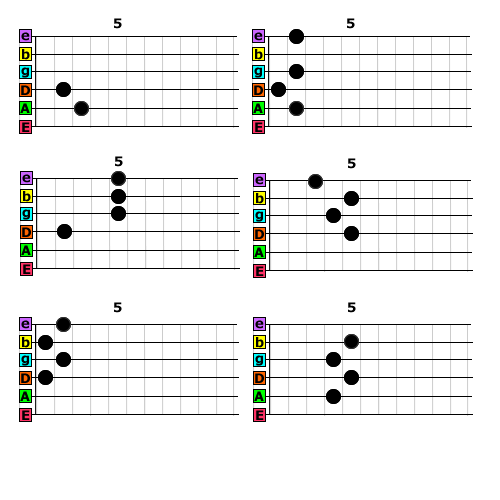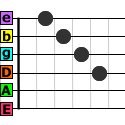dcuny wrote:Diminished chords are interesting animals.
This is one of the things I like about the fifth chord in the set of six chords, since it works nicely in a series, and it also is the same finger pattern as the last chord, so from one pattern there are a lot of useful chords, because the same finger pattern works on the lowest-pitch four strings, although it is a very strange chord on the lowest-pitch four strings . . .
And since I have not done a lot with Roman numeral notation and the terms "augmented" and "diminished" with respect to general classes of chords (as contrasted to individual notes or intervals), the only one of these chords that I specifically call a "diminished" chord is the fifth chord, so I need to ponder the general classification usage of "diminished" for a while . . .
dcuny wrote:From a jazz perspective, the viiº can be considered a rootless V7 chord.
One of the things I do to simplify music notation is to do everything on the treble clef, adjusting it downward by one or two octaves for something like viola (one octave downward) or cello and bass (two octaves downward), since everything else is too high to go one or two octaves above for the instruments I do with music notation, especially with synthesizers, since they tend to have a lot of harmonics and overtones that clash when the notes are too high . . .
From my perspective, not using a key signature is more elegant mathematically, and it is considerably easier to understand, since for all practical purposes it is an absolute mapping of the notes on a grand piano, at least the way I learned them, and I tend to minimize the use of flats and sharps so that if a note is a semitone too high, then I lower it by using the flat sign, but if a note is a semitone too low, then I raise it by using a sharp sign . . .
For example, if a B is a semitone too high, then I make it a B♭ rather than an A♯, although for an F♯, I call the fourth an A♯ rather than a B♭. So flats tend to be used only for stuff where there is an F chord, although not always . . .
In other words, I use flat and sharp pretty much the same way as minus and plus . . .
All the notes on electric guitar on fine, as well as "chimes", but I tend to reserve the highest set of frets for occasional use, where for the most part I keep lead guitar solos somewhere in the range of the 3rd fret to the 15th fret for the index finger, which usually is what I call the "1" of a "boxed" pattern, although not so much in the sense of the way "caged" is used . . .
For example, I do a lot of what I call "dot diagrams", and when they look like something that is easy to remember, I give them a mnemonic name, where the dot diagram for virtually every
Blues,
Rhythm and Blues, and
Rock and Roll lead guitar solo ever recorded is the one I call "hY", but I also call it the "Louie Louie" pattern. There are other notes, and it actually extends to the low-pitch "E" string, but it is easier to remember when it looks like "hY" . . .
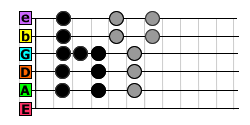
The extended flavor is the "hY2" dot diagram . . .
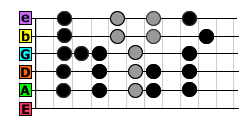
So, the Roman numeral stuff is not going to make a lot of sense to me, because as best as I can determine it requires specifying a key, which is fine if everything is in the key of C, since I simply do not think in terms of different keys, where as noted in an earlier post, my strategy is that the "key" of a song tends to be the root note of the primary chord of the verse, so for example if one is playing "Louie Louie" (The Kingsmen) where the first chord of the verse is A Major, then it is in the "key" of A, which might not be the real key for all I know . . .
In other words, the "1" in the Nashville Numbering System is the "key" here in the sound isolation studio, which is entirely different from a proper "key signature" . . .
So, at present viiº and V7 are not going to make much sense to me . . .
dcuny wrote:In reference to the overtone series, the diminished chord lacks both a perfect fifth and a major third, making it a very dissonant sound. It's a stack of minor thirds, and typically the 4 note version adds yet another minor third, and is called a º7 (diminished 7 or just dim7).
While it's called a dim7 chord, but it's really a dim6. Go figure.
QUESTION: What is the definition of "overtone series", which is a new term for me?
I like the concept of a "stack of minor thirds", which makes sense geometrically, and also makes sense regarding the "dim6" observation, at least in the sense that I map "relative minor third" to a "minor sixth", based on the "Sleepwalk" (Santo & Johnny) pattern (C, Am, F, G), where Am is the relative minor third of C, but it also is the minor sixth in one way or another, except that as a note it is sixth but as a chord it is a minor sixth rather than a major sixth, which probably is strange, but it makes sense to me . . .
dcuny wrote:The dim7 has a particularly useful quality that any of the notes could be considered the root. Said another way, none of the notes in a dim7 is a particularly strong root. So it can be used to harmonize a passing dissonant tone without giving it undo harmonic emphasis.
As long as "dim7" is the fifth chord in the six chord pattern, which I call a "diminished" chord, then this makes sense to me, because it is sufficiently ambiguous that if I play it at the wrong location by a fret or two, I can slide it upward or downward, and it fits, even if it takes a several slides to land it somewhere that sounds either "good" or "off-the-wall", where an example of "off-the-wall" is the lead guitar solo that Mark Farner played on "The Loco-Motion" (Grand Funk Railroad), which is what I call a "textural" lead guitar solo, where it basically transcends the general concepts of being "on key" and "in tune", yet it works, and it has a lot of "in-between" notes that are not on a properly tuned grand piano, which makes it both illogical
and logical, which makes it
paradoxical . . .
"The Loco-Motion" (Grand Funk Railroad) -- YouTube recorddcuny wrote:On the other hand, your chord - a C#m7b5 - is used less frequently. It's diatonic viiº7 in the key of D Major. Plus, it's got a "true" dominant 7th, which makes it function as a temporary V7.
I did a bit more research on this chord, since it is an interesting chord, and as noted in my system, this is what I call an Em6, which I verified, but the notes are in a different order than when it is called a C#m7b5, which also is the correct name, except that I would not call it a C#m7b5 chord . . .
I think the difference is that the order of the notes does not matter so much in the way I name chords . . .
However, in the explanation for the "Stormy Monday" chord, I made a mistake, and the A9 actually is a D9, which makes the last chord in the set of six chords an A9, since the identifying note is the one on the low-pitch "
D" string, which is a G, except that it is a whole step lower, so the note that identifies the chord is A, which is a bit confusing, but it makes sense to me . . .
So, it can be an Em6 or an A9 . . .
The logic on this is that when I play the "Stormy Monday" chord, which with the corrected name is D9, I play the note on the 5th fret of the high-pitch "e" string, as well, which I suppose makes it a D9 with an added A, and the four highest notes of this five-note chord are the same as the four notes of the last chord when it is played such that the note on the low-pitch "
D" string is at the 10th fret, which is a whole step below the D at the 12th fret . . .
In other words, if you play an A Major Barre chord at the 5th fret and then do a half-step downward slide to the D9 (playing the five-note version) at the 5th fret, where the lowest note of the chord is the D on the low-pitch "A" string, this sounds the same as playing the last chord of the set of six chords but where the note on the low-pitch "D" string is a C at the 10th fret, where you do the half-step downward slide from the 11th fret . . .
It is a bit confusing, but the "Stormy Monday" D9 at the 5th fret basically sounds like the last of the six chords played so that the note on the low-pitch "D" string is a C at the 10th fret, where the primary difference is that the D9 actually has D as its root, while the other chord has no D, at all, which probably is a play "by ear" thing . . .
Explained another way, the lowest note of a chord is important to me only in the sense of chords where it definitely can be used quickly to map the chord to a bass guitar note, which is the case with low and middle Barre chords, for sure . . .
For example, if I need to play a C Major quickly, then I can play either a low Major Barre chord at the 8th fret or a middle Major Barre chord at the 3rd fret, since both of the lowest notes are C . . .
Whenever possible, I like to have the lowest pitch note be the identifying note, since it is easier to remember, and it works for a lot of chords, but there are other chords where there is no identifying root note, which in some respects makes no sense, except that even though I make an effort not to know the actual key signature, I play songs in only a few key signatures, which makes sense when you consider musical modes . . .
If one plays a scale with only white keys on a grand piano starting at Middle C, then the mode is Ionian, but if the starting note is D, then it is Dorian, and so forth (Ionian, Dorian, Phrygian, Lydian, Mixolydian, Aeolian, Locrian), which is great, except that from my perspective all of them are C or perhaps A minor, which makes sense to me . . .
So, after pondering all this stuff for a while, I think that I probably minimized the set of chords that I need to know in order to play songs in key signatures that are easy to play on electric guitar and are easy for me to sing, which for me is a way to simplify everything, where yet another reality is that the primary reason I learned Barre chords was to be able to play songs when there is a horn section, since horn players tend to want to play songs in key signatures that are not easy for guitar players, since they exclude all the easy open-position chords, which makes no difference when one is playing bass guitar, so after pondering it for a while, I realized that Barre chords make it just as easy to play songs on guitar when there is a horn section as it is to play songs on bass guitar . . .
And this refreshes my memory on the sequence of events, which happened when I was playing electric bass before I decided to teach myself how to play rhythm guitar, and the guitar player in the musical group was having a bit of difficulty playing songs in a different key when we had a trumpet player (who was very good and like most horn players knew a lot about music theory), so the trumpet player told the guitar player to "just play Barre chords", which made no sense to me, so sometime later I asked the guitar player what "Barre chords" were, which is the way I learned the first few Barre chords, as well as the fact that if you know Barre chords, then horn sections cannot make you crazy by demanding that you play songs in difficult key signatures, so for example if I know "Stormy Monday" in A and a horn section appears and wants to play it in E♭, F, or B♭, then I shift the pattern to middle Barre chords for E♭ but have options if it is F or B♭ . . .
And now that I think about it a bit more, I do not have a name for the last of the six chords, since I remember it as being like a middle "Stormy Monday" but shifted upward or downward, depending on where the middle "Stormy Monday" happens to be . . .
dcuny wrote:The dim7, lacking a "true" 7th, has no such harmonic function, which is why it's ideal as a passing chord.
This is one of the things that I like about this chord, and depending on where it starts, you can do several types of transitions--simple one chord, two chord, three chord, and if it starts below the 5th fret as many as four to six chords where you can do a six-chord "walk-up" from the lowest possible position (fingers on the 1st and 2nd frets, which is the fifth chord in the diagram) all the way to the 16th and 17th frets, and then land on a low Barre G Major . . .
Lots of FUN! 
P. S. I am going to ponder the Roman numeral system for a while, but I think that it is a bit too complex for me at present . . .
Last year, I devoted quite a bit of attention to making sense of musical modes, but after a while I decided that it made more sense to focus on scales, since there are more scales than musical modes . . .
P. P. S. I will proofread this for accuracy, spelling, and grammar later . . .
